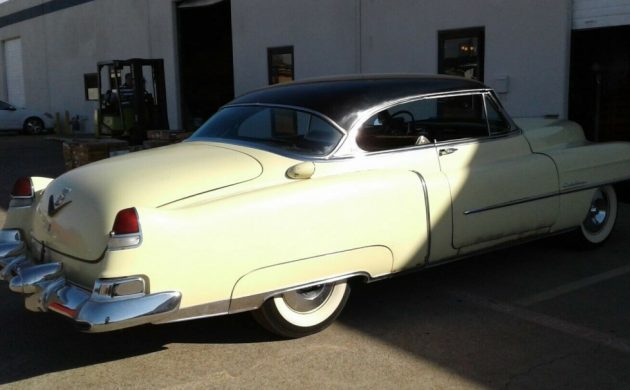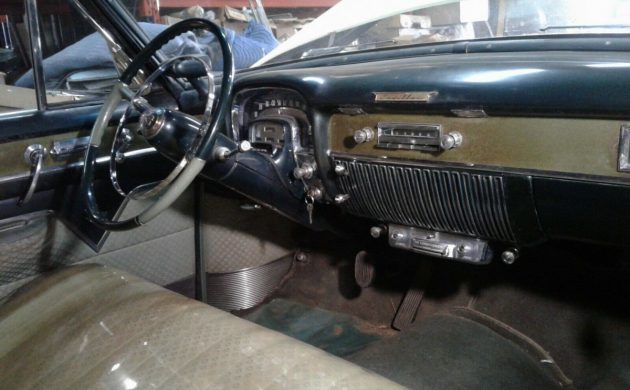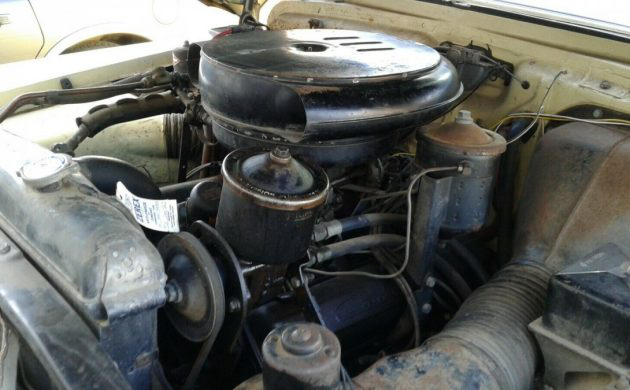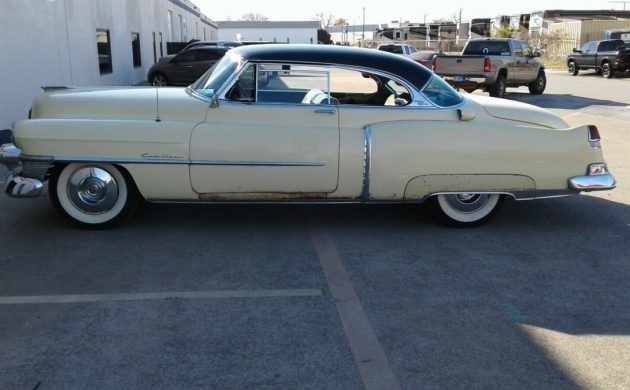Stored For 40 Years: 1953 Cadillac DeVille
After spending 40-years parked and largely forgotten, this 1953 Cadillac Series 62 Coupe DeVille has emerged and has been returned to active duty. It wears its original paint and is an extremely solid car that is ready for a new owner to drive and appreciate. Barn Finder Ikey H referred the Cadillac to us, so thank you so much for that Ikey. Located in Euless, Texas, the Cadillac has been listed for sale here on eBay. With bidding at $11,100, the reserve hasn’t been met. There is also a BIN option available, and this has been set at $23,500.
The Cadillac is finished in an attractive combination of Artesian Ochre with a Black top. The paint is said to be original and is in quite good condition for its age. It could certainly be left as it is because it does have quite a nice shine to it. If the next owner is seeking perfection, then a repaint could be undertaken when the only rust in the vehicle is attended to. This is in the rockers, and a replacement set is included with the car. Some of the external trim and chrome is also going to require restoration or replacement, so this could be tackled at the same time.
The interior trim of the Cadillac also looks quite good, with the original Light Green cloth and Dark Green leather seat upholstery being protected by clear plastic covers. I initially thought that the leather was black, but it is about the darkest shade of green that you are ever likely to see. There are a few areas that are showing their age a bit, especially some aspects of the door trims and the carpet, but overall, it is quite a good survivor-grade interior. The car originally featured air conditioning, but the compressor for this is now missing. The owner also identifies an issue with the power windows. The motor and pump have been rebuilt, but the windows still don’t move. He suspects a blocked line, and this will need to be investigated.
Powering the Cadillac is the 331ci V8 engine, which was introduced into the range in 1949 to replace the aging 346ci flathead engine. The benefits of this engine were two-fold, with it being both lighter and more powerful than its predecessor. With 200hp on tap, the Coupe DeVille was now a pretty decent performer, and fuel economy had also improved markedly. The power from this engine found its way to the rear wheels via a 4-speed Hydramatic transmission, while the car also featured power steering as standard. After sitting for four decades, our feature car needed a bit of work to revive it, but the owner has undertaken this, and the Cadillac has been returned to good mechanical health. Amongst the work performed was a clean and seal of the fuel tank, a completely new braking system was installed, along with a new water pump, a replacement reproduction radiator, and all new hoses and belts. The car is now said to run nicely, with the transmission shifting smoothly.
This 1953 Cadillac is a true survivor, and it has weathered the past 40-years of isolation quite well. It really wouldn’t take much work to return it to its former glory, although it could just as easily be driven as it currently stands. Values on the 1953 Coupe DeVille have been rising slowly but steadily in recent years, with really nice, original examples frequently selling for figures upwards of $50,000. This one needs some work to reach that sort of level, but it would appear that at the BIN price, it might not be a bad project to take on.
Auctions Ending Soon
 1969 Ford MustangBid Now13 hours$1,050
1969 Ford MustangBid Now13 hours$1,050
 1965 Ford Falcon Station WagonBid Now3 days$2,300
1965 Ford Falcon Station WagonBid Now3 days$2,300
 2002 Jaguar XK8 ConvertibleBid Now4 days$4,250
2002 Jaguar XK8 ConvertibleBid Now4 days$4,250
 1979 Chevrolet Camaro Z/28Bid Now5 days$4,500
1979 Chevrolet Camaro Z/28Bid Now5 days$4,500
 1960 Dodge D300Bid Now5 days$300
1960 Dodge D300Bid Now5 days$300






Comments
`53 was the first year GM offered AC on it’s regular production cars. Usually reserved for limos & sedans of the day, it’s rare to see on a 2dr. hardtop. As solid as this looks, it would be well worth the expense of fixing up, simply for the factory air!!
With so many cars in the G.M. line with 4 speed hydro ,why did Chevy stick with that darn powerslide for so long ?
Because it was cheaper to make!
Remember that GM was making a whole bunch of different slush boxes by the late 50s, early 60s. Hydramatic, Powerglide, Turboglide, Dynaflow, Rotohydramatic etc.
The hydros were very costly to build very big and heavy. Powerglides were a lot simpler to manufactor.
In `53, GM’s transmission plant had a horrible fire that destroyed the entire plant. Buicks, Oldsmobiles & Pontiacs were given power-slushes until the plant could be rebuilt.
Comment on the fire. It was the Hydramatic plant that was destroyed. The common substitution for Olds and other nameplate was a Dynaflow.
Also gotta wonder why they went back to 3 speed automatics for all of G.M.s big cars. wasn’t that going backwards a little bit. With that said this is one nice looking Caddy. What a classic Cadillac should be. Hop the power windows isn’t a hard fix.
A friend father had a ’53 convertible, the story goes as he was putting the top up one of the hydraulic lines broke, all of the windows went down, seat went all the way back and top went back down. He said everything was hooked together, and after that the car always smelled like trans. fluid
The original 4 speed hydramatic wasn’t a 4 speed overdrive transmission… it had a low first gear for more torque multiplication. The final gear was 1.00. By the mid sixties when the Turbo 400 was introduced to replace the 4 speed hydramatic, engines were producing lots of torque out of big cube engines, so only a 3 speed auto was needed. GM went back to a 4 speed automatic when overdrive was needed for fuel economy…
Yes, the Hydramatic didn’t use a torque converter, just a simple fluid coupling. That’s why it needed the low 1st gear.
I was gifted one of these caddys back in the early 70’s. After a tuneup, replacing rusted brake lines and a holy exhaust, it was quite a runner. As you mentioned, Anthony, these had a super-low first gear, you could really peel out. No park gear, leave it in reverse when shutting off. The only negative was the power windows and power seat were hydraulic, using brake fluid as the medium. The system leaked, and nowadays, the smell of brake fluid always brings this car back to mind!
If this were nine I’d replace hydraulics in the doors and seats with electric motors. Leaking problem solved.
Boy! I could see Mom driving this car around town while we update her Buick
LeSabre. First thing I’d do is ditch the
hydraulic window lifts and replace them
with more reliable electric motors. Hydraulic fluid is very corrosive and will eat anything it comes in contact with.
Next up would be upgrading the electrical
system to 12 volts so that a modern alternator could be used. And by all means, get the factory air working again.
Correct me if I’m wrong, but didn’t the
compressor sit in the trunk on these? If
it does, you’ll have the devil’s own time
finding a replacement unless you add a
Vintage Air unit to take its place. Next
would be a set of Sabre rims off an El
Dorado or a set of nice wire rims wrapped
in Coker WSW tires. That would be it for the modifications. Then, just drive and
enjoy.
The evaporator was behind the rear seat. The compressor is engine driven. Note the air intakes on the quarter panels. That’s an indication of the location of the A/C unit.
This car would already have a 12 volt system. 53 was the first year for Cadillac.
The A/C compressor is mounted on the engine in a conventional manner. The evaporator is located in the trunk, so there would be very long lines running from the compressor to the trunk. The compressor was large and unique, and may be hard to find. The cold air will blow from the rear shelf area behind the rear seat. I am not sure, but some early A/C cars used tubes to move the cold air along the roof of the car, and then blow down on the passengers. You can see the air intake vents to the A/C unit on both rear fenders. One of the cars on PhantomWorks had a factory A/C system installed in a Cadillac. If you can watch that episode, you can learn a lot about that system. GM cars of this era used one hydraulic pump that could be used to move a convertible top and power windows and seats. If a leak developed in any part of the system, none of these items worked, and you would have to clean up hydraulic fluid.
I drove a 1953 Cadillac hearse in the late 1960’s. Because of the hydromatic plant fire, it had a dynaflow. Chevrolet powerglides were built for a lo cost car and as an alternative to a three speed manual. The performance bar was low.
These early Caddies, had the best looking grills! Anyone remember the Harry Winston Jewelers ads featuring these front ends?
20 years ago one of these was my daily driver. It was a wonderful car. Wish I had not sold it as it looked like new. The price seems very high to me for what you are getting.
I tried looking up the paint code for this 53 Cadillac and couldn’t find any color codes to match what it says the original paint code #23 is suppose to be, so I am assuming that the paint code stamped on the plate is either incorrect or this is not the original color for this car, can anyone help with information about the Paint code on this Cadillac, this is the same year and type of car My Father had when I was born He was holding me while standing in front of the 53 Cadillac He owned at that time.
Year’s ago I collected three 53 Caddy Coupe”s with the intention of building one from the amassed parts. During this time I found a real decent 53 on Ebay and bought it for $9000, figured it would cost more to do the build than that. I drove it to Goodguys in Scottsdale and got an offer of $13,000 so away it went.
This is a beautiful automobile. I always loved the tail light treatment and how it flowed into the quarters, plus the opening left tail light to reveal the gas cap, so cool. Add the fact it is a 2 door hardtop and factory AC with the air scoops on the quarters, and the Autronic Eye, just a great car with nice options. I first thought it was missing the rear clear acrylic A/C ducts, but noticed the vents in the rear deck. What years had the tubes?
I’m surprised it’s still available for this price!! It’s a lot of car for the money!! That front bumper would make any Dolly Parton fan proud!!!
The scoops remind me of the ones on the Corvette from several days back.
I love it ! So the evaporator in the back had to rely on air flow through the scoops when the car was moving ? No electric fan of any sort ? Except maybe at front for heater core ? Interesting. I’d love to see pictures of the compressor. Did the pipes for the evaporator run between roof and headlining ? Also love to see the hydraulic pump for the top, seats and windows and associated actuators.